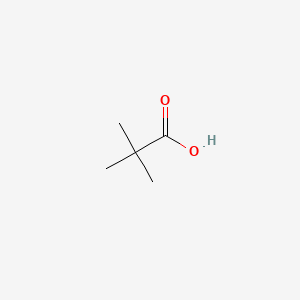| MeSH term | MeSH ID | Detail |
|---|---|---|
| Hemolysis | D006461 | 131 associated lipids |
| Otitis Media | D010033 | 12 associated lipids |
| Arrhythmias, Cardiac | D001145 | 42 associated lipids |
| Body Weight | D001835 | 333 associated lipids |
| Psoriasis | D011565 | 47 associated lipids |
| Urinary Tract Infections | D014552 | 11 associated lipids |
| Seizures | D012640 | 87 associated lipids |
| Dermatitis | D003872 | 30 associated lipids |
| Vitamin E Deficiency | D014811 | 29 associated lipids |
| Hyperinsulinism | D006946 | 27 associated lipids |
Pivalic acid
Pivalic acid is a lipid of Fatty Acyls (FA) class. Pivalic acid is associated with abnormalities such as Renal carnitine transport defect, Carnitine deficiency, Urinary tract infection, Otitis Media and Chronic infectious disease. The involved functions are known as carnitine transport, Uptake, inhibitors, Oxidation and Intestinal Absorption. Pivalic acid often locates in Grey line. The related lipids are pivalic acid and Fatty Acids.
Cross Reference
Introduction
To understand associated biological information of Pivalic acid, we collected biological information of abnormalities, associated pathways, cellular/molecular locations, biological functions, related genes/proteins, lipids and common seen animal/experimental models with organized paragraphs from literatures.
What diseases are associated with Pivalic acid?
Pivalic acid is suspected in Otitis Media, Renal carnitine transport defect, Carnitine deficiency, Urinary tract infection, Chronic infectious disease and other diseases in descending order of the highest number of associated sentences.
Related references are mostly published in these journals:
| Disease | Cross reference | Weighted score | Related literature |
|---|
Possible diseases from mapped MeSH terms on references
We collected disease MeSH terms mapped to the references associated with Pivalic acid
PubChem Associated disorders and diseases
What pathways are associated with Pivalic acid
Lipid pathways are not clear in current pathway databases. We organized associated pathways with Pivalic acid through full-text articles, including metabolic pathways or pathways of biological mechanisms.
Related references are published most in these journals:
| Pathway name | Related literatures |
|---|
PubChem Biomolecular Interactions and Pathways
Link to PubChem Biomolecular Interactions and PathwaysWhat cellular locations are associated with Pivalic acid?
Visualization in cellular structure
Associated locations are in red color. Not associated locations are in black.
Related references are published most in these journals:
| Location | Cross reference | Weighted score | Related literatures |
|---|
What functions are associated with Pivalic acid?
Related references are published most in these journals:
| Function | Cross reference | Weighted score | Related literatures |
|---|
What lipids are associated with Pivalic acid?
Related references are published most in these journals:
| Lipid concept | Cross reference | Weighted score | Related literatures |
|---|
What genes are associated with Pivalic acid?
There are no associated biomedical information in the current reference collection.
What common seen animal models are associated with Pivalic acid?
There are no associated biomedical information in the current reference collection.
NCBI Entrez Crosslinks
All references with Pivalic acid
Download all related citations| Authors | Title | Published | Journal | PubMed Link |
|---|---|---|---|---|
| Barroca N and Jacquinet JC | An access to various sulfation patterns in dermatan sulfate: chemical syntheses of sulfoforms of trisaccharide methyl glycosides. | 2002 | Carbohydr. Res. | pmid:11950464 |
| Li C et al. | Enantioselective covalent binding of 2-phenylpropionic Acid to protein in vitro in rat hepatocytes. | 2002 | Chem. Res. Toxicol. | pmid:12437340 |
| Overgaard J et al. | Host-guest chemistry of the chromium-wheel complex [Cr8F8(tBuCO2)16]: prediction of inclusion capabilities by using an electrostatic potential distribution determined by modeling synchrotron X-ray structure factors at 16 K. | 2002 | Chemistry | pmid:12391657 |
| Niezen JH et al. | The effect of feeding sulla (Hedysarum coronarium) or lucerne (Medicago sativa) on lamb parasite burdens and development of immunity to gastrointestinal nematodes. | 2002 | Vet. Parasitol. | pmid:11934463 |
| Bursten BE et al. | Oxalate-bridged complexes of dimolybdenum and ditungsten supported by pivalate ligands: ((t)BuCO(2))(3)M(2)(mu-O(2)CCO(2))M(2)(O(2)C(t)Bu)(3). Correlation of the solid-state, molecular, and electronic structures with Raman, resonance Raman, and electronic spectral data. | 2002 | J. Am. Chem. Soc. | pmid:11902897 |
| Mitani MM et al. | Kinetics and products of reactions of MTBE with ozone and ozone/hydrogen peroxide in water. | 2002 | J. Hazard. Mater. | pmid:11744205 |
| Arulsamy N and Bohle DS | Multiplicity control in the polygeminal diazeniumdiolation of active hydrogen bearing carbons: chemistry of a new type of trianionic molecular propeller. | 2001 | J. Am. Chem. Soc. | pmid:11686687 |
| Darbeau RW et al. | Boundary conditions on the partitioning of deaminatively generated benzyl cations. | 2001 | J. Org. Chem. | pmid:11304187 |
| Broderick TL et al. | Short-term carnitine deficiency does not alter aerobic rat heart function but depresses reperfusion recovery after ischemia. | 2001 | Can. J. Physiol. Pharmacol. | pmid:11697749 |
| Cossy J et al. | Synthesis of stereotriads by oxymercuration of substituted cyclopropylcarbinols. | 2001 | Org. Lett. | pmid:11483062 |
